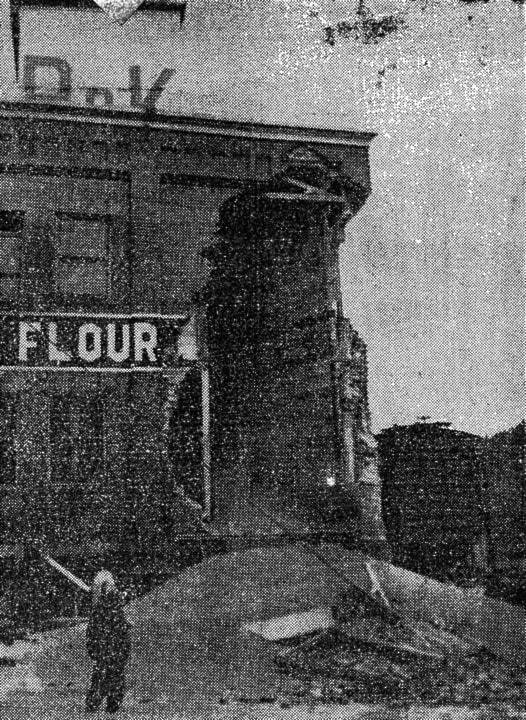For every roadblock a historian hits, now and then you get a break — though often it just ends up posing new questions. Here are three such examples.
When Ellison’s celebrated the centennial of its building last year, its staff pointed out something I’d never noticed but now wonder how I missed.
The bricks on the building’s northeast side are a different colour than the rest — evidence of where the wall collapsed and was rebuilt. At the time I wasn’t able to determine what happened and when. But I’ve since learned that it occurred on August 11, 1947.
According to a caption in the Nelson Daily News that accompanied the photo seen at left: “A gaping hole was left in the building of Brackman-Ker Company Ltd. at Nelson after a section of the Josephine Street wall collapsed, emptying 100,000 pounds of wheat onto the ground. A possible loss of $4,500 was estimated after the mishap. The west side, facing the track, was also said to be in danger of falling.”
(Ellison’s bought the building from Brackman-Ker in the early 1950s.)
A few more details appeared in a squib in the Vancouver Province: “Weight of the grain was believed to have pushed out the wall. A car parked nearby missed being crushed by inches.”
But I couldn’t find anything more. I don’t know how long it took to clean up or rebuild.
CANDLE POWER: I’ve written before about Nelson’s free porch light policy, wherein the city once provided residents with non-metered circuits for their verandas.
It was a cheap form of street lighting and also a source of bragging rights — “Hey, we’ve got so much power, we can give it away.” It rated mentions in the New York Times, Christian Science Monitor, and Saturday Evening Post.
As of 1960, the bylaw read: “One 50-watt lamp or its equivalent shall be permitted to be used without charge if suspended outside the front door of each residence within the city.”
But I never did learn exactly when it was adopted. I still don’t quite have the answer, but I’m getting closer.
A Daily News story of November 2, 1909 related how “Householders who use electric light exclusively in their domiciles will in future be permitted to burn an eight candle power light on their front porch at the expense of the city and business men on Baker street who use electric light in their stores will be given a 16 candle power lamp free to burn during the night.”
Previous to this, only four candle power light was granted for porches.
Candle power is, needless to say, an obsolete term, but it was once a common measure of luminous intensity. The same year that Nelson city council decided to provide residents with brighter porch lights, a meeting of nations redefined candle power in terms of an electric lamp with a carbon filament.
I don’t know when the porch light policy was finally repealed, if it ever was, but it no longer applies. Nelson Hydro is trying to find and remove the remaining rogue circuits.
(I am indebted to the indefatigable Peter A. Watson of West Vancouver for locating the above-mentioned items.)
A BUDDHIST MEMORIAL: Before the creation of interpretive signs along the Slocan Valley rail trail last year, there was only one surviving indication of the internment of Japanese Canadians in the lower valley during World War II.

At the back of the Slocan cemetery is a fenced enclosure, within which is a rock slab with two trees growing on top and a wooden pillar in between with Japanese inscriptions on all four sides (pictured at left).
The west side is apparently a Buddhist prayer for the dead, which loosely translated means “Buddha have mercy on me.” The south side says “Rebuilt — Slocan — Donated.” The characters are bright enough that they may have been repainted at some point. But the other two sides are illegible.
The origin and meaning of this monument has been the source of considerable speculation and puzzlement. Who put it there and when? Is it actually a burial site?
We now have a few answers thanks to Simon Fraser University, which digitized The New Canadian, the Japanese-Canadian newspaper published in Kaslo during the internment years.
According to a story in the September 2, 1944 edition: “Plans have been made by the Slocan Buddhist Mission Society to erect a memorial monument in commemoration of the deceased who were cremated at the Slocan cemetery before the New Denver crematorium was completed. Permission has been granted to erect this monument and work is expected to begin in the near future.”
While the inscribed pillar may be a more recent addition, this does appear to be the genesis of the monument. The Slocan Buddhist congregation was led by Rev. Kenryu Tsuji (1919-2004), who went on to become a bishop in San Francisco.
James Draper built the New Denver crematorium in 1943. At least 22 Japanese Canadians died in and around Slocan in 1942-43, although not all were necessarily Buddhists. It will take some checking of death registrations to figure out exactly who among them was cremated at Slocan.
The Village of Slocan has long been interested in restoring the overgrown site and adding interpretive signs, but wanted to know more about it first to respect cultural sensitivities.
